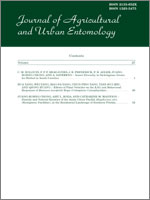Despite a number of studies on the prevalence of Nosema across the United States, limited information exists regarding comparative rates of N. ceranae and N. apis infection within individual states. We conducted a study to detect N. ceranae and N. apis using molecular diagnostics on managed honey bee colonies from New York and South Dakota. A total of 1200 apiaries were visited by New York state bee inspectors in 2009, and samples were collected from 4300 honey bee colonies. A total of 1023 apiaries were sampled from South Dakota in 2009. Microscopy was used to detect Nosema spore presence and to estimate the intensity of infection by estimating spore counts in positive samples. Nosema was detected in 528 (44%) of the New York and 300 (29%) of the South Dakota sampled apiaries. A total of 464 New York and 290 South Dakota Nosema-positive apiary samples were subjected to molecular diagnostic polymerase chain reaction (PCR) analysis. For the New York samples, 250 (54%) were PCR-positive for Nosema, with 96.8% being N. ceranae, 0.8% N. apis, and 2.4% both N. ceranae and N. apis. For the South Dakota samples, 122 (42%) were PCR-positive for Nosema, all of which were N. ceranae.
How to translate text using browser tools
1 January 2013
Prevalence of Nosema from Managed Honey Bee Colonies in South Dakota and New York
Allen L. Szalanski,
Justin Whitaker,
Amber D. Tripodi,
Paul Cappy
ACCESS THE FULL ARTICLE
It is not available for individual sale.
This article is only available to subscribers.
It is not available for individual sale.
It is not available for individual sale.
<
Previous Article
|
Apis mellifera
molecular diagnostics
Nosema apis
Nosema ceranae
PCR





